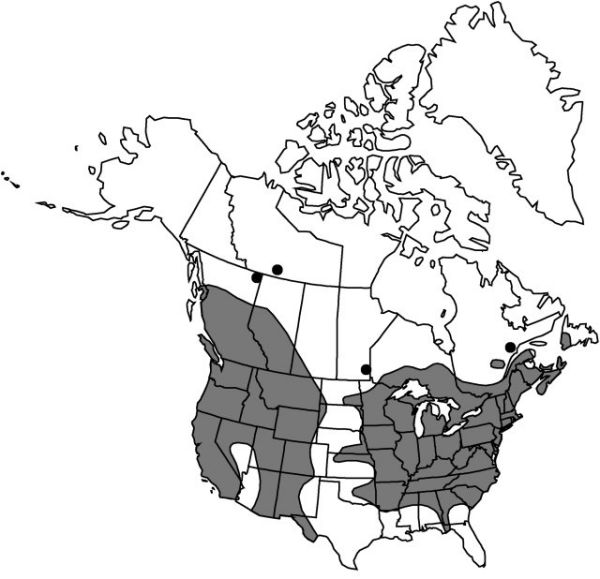Maianthemum racemosum
Enum. Hort. Berol. Alt. 1: 343. 1821.
Plants terrestrial, to 12.5 cm. Rhizomes sympodial, cylindrical, units 30–40 cm × 8–14 mm, sometimes multiplied, roots scattered. Stems erect or arching, 7.5–12.5 dm × 7–9 mm. Leaves 7–12, sessile and clasping, or petiolate; blade elliptic to ovate, 9–17 × 5–8 cm; base rounded or tapered; apex acute or caudate. Inflorescences paniculate, 70–250-flowered, branches well developed, pyramidal. Flowers 3-merous; tepals inconspicuous, 0.5–1 × 0.5 mm; filaments 1 × 0.5 mm; anthers 0.5–1 mm; ovary globose, 1 mm wide; style 0.1–0.3 mm; stigma obscure; pedicel 0.5–1 × 0.5 mm. Berries green with copper spots when young, maturing to deep translucent red, globose or 3-lobed, 4–6 mm wide. Seeds 1–4, globose, 2.5–4 mm. 2n = 36, 72, 144.
Distribution

North America, n Mexico
Discussion
Subspecies 2 (2 in the flora).
Maianthemum racemosum is sometimes cultivated. It was described as apomictic (A. L. Gorham 1953) but is much in need of cytogeographic and reproductive biological studies.
Selected References
None.
Key
| 1 | Stems erect; leaves sessile, clasping, blade base rounded; apex of third leaf below inflorescence acute, shorter than 2 mm; w North America. | Maianthemum racemosum subsp. amplexicaule |
| 1 | Stems arching; leaves petiolate, blade base tapered; apex of third leaf below inflorescence caudate, 12–25 mm; e North America. | Maianthemum racemosum subsp. racemosum |
"thicker" is not a number."dm" is not declared as a valid unit of measurement for this property.